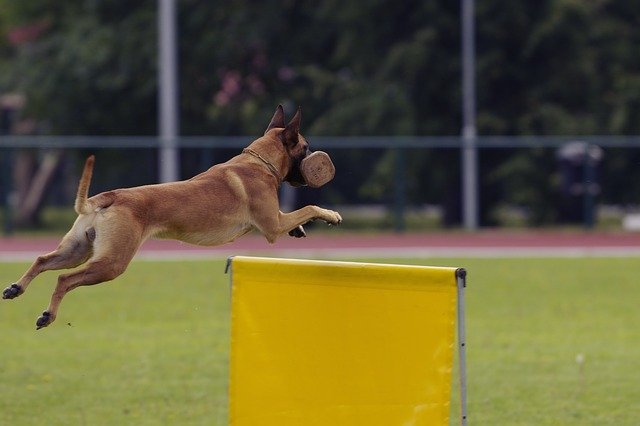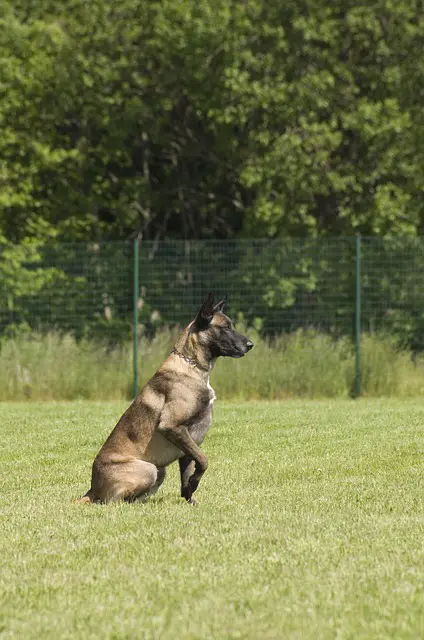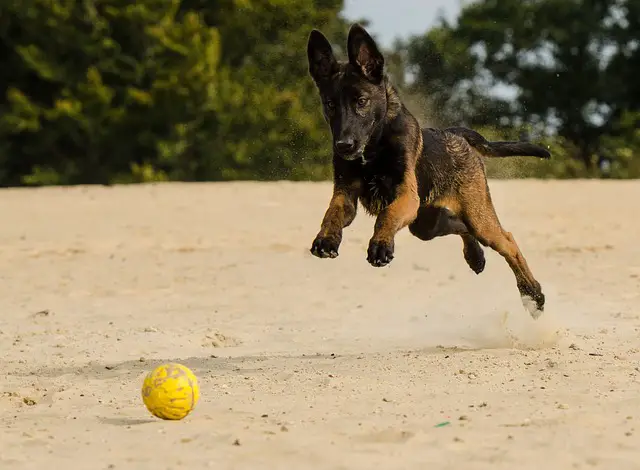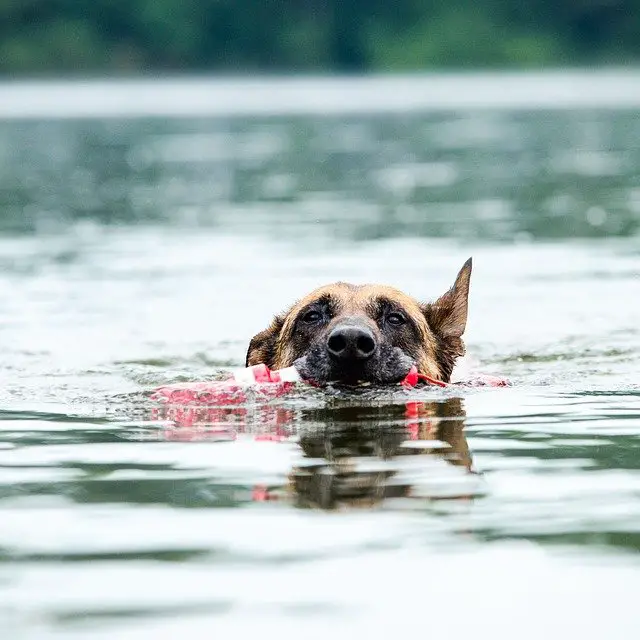When it comes to dog training. Knowing the personality of the breed you’re working with is a vital step toward seeing success. Belgian Malinois are energetic, extremely intelligent dogs that are best suited for working homes.
What that means is without a job to do and a lot of structured obedience training. This crazy smart dog puts its intelligence into finding its own job.
That job may be tearing apart your couch to see if there’s anything fun inside. Breaking out of the house to see where mom or dad goes all day or harassing other members of the family.
So, if you’ve made the exciting decision to bring home a Belgian Malinois. Make sure you’re ready to dedicate the time necessary to train your new family member.

For your dog’s vitamin supplement, food, toys, or other dogs product please visit the Sundays for dog website.
Belgian Malinois Training Lingo
First, it’s important to understand training terminology so you know how to best proceed.
Drive:
This term refers to your dog’s desire to work for a specific item. If you have a hyper dog, that’s classified as a high drive.
If you have a really mellow dog, your dog is low drive. You want to use certain items to channel their drive accordingly.
Toy Drive
(toys motivated): Toy drive means that your dog wants to interact with and gets excited about playing with different toys.
Dogs that always want to play fetch, or tug, are driven by toys (toy motivation) and that means you’ll benefit from the use of toys to help their training.
Food Drive
(food motivated): This means that your dog enjoys food and will excitedly perform tasks to get treats. Just because a dog is primarily motivated by toys or food, doesn’t mean you have to pick just one.
All it means is by identifying what they’re more motivated by, you’ll be able to keep their attention better during training.
Engagement:
Engagement is the term used to describe how focused your dog is. If you’re telling your dog to sit, and they’re running around the park paying attention to nothing but you, that means they aren’t engaging with you.
It’s important to practice and build engagement with your Belgian Malinois to train in higher-level obedience.
If your Malinois most favorite thing to play with, you’ll have no problem ignoring all the other barking dogs in favor of earning rewards from mom or dad.
Rewards and Corrections:
Rewards are what you give a dog for performing the task you ask for, and corrections are a negative consequence. A correction may just be a verbal no, or it could be something like a collar pop to get their attention.
Now that we understand some basic lingo of dog training. Let’s dive into how to use that lingo and effectively train your Belgian Malinois, including important Belgian Malinois training commands.
To check your Belgian Malinois health status or their DNA, please visit the Embark vet website for all the help you may need.

Clicker and Marker Training
Belgian Malinois dogs respond very well to clicker/marker training. It’s a style of training that allows them to learn things as you’re teaching them with clear communication by marking what they do correctly with noise and reward.
To delve into what marker training is, the best source is Karen Pryor, who was one of the first to develop it. Join online courses such as Brain Training for dogs and books, see the collection of books for Belgian Malinois training books is a great resource to educate yourself on the basics and fundamentals of clicker training. you can buy the following book online on Amazon by clicking the BUY NOW

Where To Start?
This highly sensitive dog breed is people, pleaser. They love to work to make their owners happy and can struggle with stress and confusion if an owner is overly harsh.
Some dogs can shake off an angry owner and not let it affect them. But your Malinois will carry that weight and need to be given positive reinforcement while being taught new commands.
Teaching Your Pup Their Name:
The best place to start with Belgian Malinois Training commands is simply by associating their name is positivity.
When you bring your puppy or dog home, make sure you pick a time when they’re hungry (right before breakfast or dinner) and start using their food to associate their name with positive attention.
Simply have their kibble in a bowl by you, say their name, and when they make eye contact give them a treat (or mark that eye contact with a clicker, if you’re following the marker training method).
Make sure you are in a calm environment with no distractions around, so that your pup has good engagement with you. This also starts teaching them to focus on you, and that you have good things for them.
Teaching Your Belgian Malinois Engagements:
With proper engagement, this often nervy breed of dog can work through almost anything. To build up engagement, work on making yourself the most fun thing your dog has around.
After coming out of the Kennel (and you certainly should be kennel training your Malinois) take them directly to go to the bathroom without much attention, reward them with a treat, then immediately go into Engagement building exercises.
Most Belgian Malinois is toy-driven, so this is a great time to bring that toy out and spend a few minutes playing like crazy. Tug, fetch, whatever they want.
The more excited you are about the game, the more excited they’ll be, and the more they’ll start learning that focusing on you is a really fun and exciting thing.
Spend only a few minutes with that type of play while building engagement, then leave them wanting more. Put the toy up, and repeat that game at least three or four times a day. The older they get and the better their focus gets, the longer they can play.

Teaching Your Belgian Malinois Out:
When it comes to Belgian Malinois Training Commands, an ‘Out’ command is vital. Belgians are called Maligators for a reason, they love to use their mouth.
Start training an out command before they’ve had any meals so that their food motivation is high. Get two of the same toy, one they can tug on, and let them tug with you.
After a second use, a really high-value treat (a treat that’s a lot better than dry kibble. Something like a tiny piece of cooked chicken, or a little hot dog piece) and put near their nose.
Don’t say anything until they release the toy. As soon as they do, say ‘OUT’ then let them have the treat. Once they seem to be understanding the command.
You can start using the second toy instead of food and working on fetch skills by saying ‘OUT’, then throwing the second toy for them to chase.
When it comes to the Belgian Malinois training command. This one can go a long way to teaching your pup that listening to your results in even better things happening.

Where To Start?
Attend a Schutzhund, Ring Sport, Dock Diving, or Agility class and training. Actually, attend a lot. By working with an educated club or training group, you’ll have the benefit of both giving your dog a job and learning high-level training in the online training course Brain Training for dogs.
Belgians have a high level of prey drive, meaning they like to chase. While building up obedience, keep them in a long line like this to prevent any accidents. While allowing them to work on leaving your side, then coming back and getting a reward.
You’re bringing home a hyper dog who needs to play, train, and work. They can be nervy, neurotic messes when not given the proper attention.
Research socialization, and why it’s important, and if you don’t plan to participate in a dog sport like the ones listed above, or something like Search and Rescue, consider getting less difficult to own a dog breed.
If you know you want a Belgian Malinois and have never been around one, it’s a good idea to look at local rescues in your area and do a few meets and greets.
Happy training!